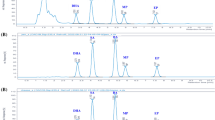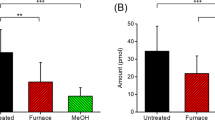Abstract
Melamine is widely being reported as a food adulterant. Although its toxicity is currently recognized, melamine adulterations of dairy products are ongoing to apparently increase the amount of protein. The study was conducted to investigate the determination of melamine amounts in chocolates containing powdered milk. In this study, 60 samples of chocolates containing powdered milk, both imported and domestic brands, were collected. The samples were prepared by solid phase extraction (SPE) and analyzed using high-performance liquid chromatography (HPLC). According to the results, melamine was found in about 94% of imported samples and about 77% of Iranian samples. Melamine concentration in imported samples ranged from 0.032 to 2.692 mg/kg, while in Iranian ones it ranged from 0.013 to 2.600 mg/kg. The mean melamine concentrations of foreign and Iranian samples were 0.685 ± 0.68 and 0.456 ± 0.73 mg/kg, respectively. Moreover, the limit of detection (LOD) and limit of quantification (LOQ) values of melamine were 0.017 and 0.052 μg/ml, respectively. The recovery rate (R%) at fortified levels of 1–2 mg/kg was found to be 89.20–95.69% with an RSD (Relative Standard Deviation) of 1.8–2.7%. Based on the study results, melamine was present in 85% of all samples and the melamine level in one Iranian brand and one imported brand was higher than the Codex Organization standard. However, the consumption of chocolates containing these low levels of melamine does not constitute a health risk for consumers.

Similar content being viewed by others
References
Venkatasami G, Sowa JR Jr. A rapid, acetonitrile-free. HPLC method for determination of melamine in infant formula, Analytica Chimica Acta. 2010;665:227–30.
Ramalingam K, Devasena T, Senthil B, Kalpana R, Jayavel R. Silver nanoparticles for melamine detection in milk based on transmitted light intensity. IET Sci Meas Technol. 2016;11:171–8.
Hau AK-C, Kwan TH, Li PK-T. Melamine toxicity and the kidney. Journal of the American Society of Nephrology. 2009;20:245–50.
Chan E, Griffiths S, Chan C. Public-health risks of melamine in milk products. Lancet. 2008;372:1444–5.
Filigenzi MS, Puschner B, Aston LS, Poppenga RH. Diagnostic determination of melamine and related compounds in kidney tissue by liquid chromatography/tandem mass spectrometry. J Agric Food Chem. 2008;56:7593–9.
Chan ZC, Lai W-F. Revisiting the melamine contamination event in China: implications for ethics in food technology. Trends Food Sci Technol. 2009;20:366–73.
Dobson RL, Motlagh S, Quijano M, Cambron RT, Baker TR, Pullen AM, et al. Identification and characterization of toxicity of contaminants in pet food leading to an outbreak of renal toxicity in cats and dogs. Toxicol Sci. 2008;106:251–62.
Zhu X, Wang S, Liu Q, Xu Q, Xu S, Chen H. Determination of residues of cyromazine and its metabolite, melamine, in animal-derived food by gas chromatography− mass spectrometry with derivatization. J Agric Food Chem. 2009;57:11075–80.
Andersen WC, Turnipseed SB, Karbiwnyk CM, Clark SB, Madson MR, Gieseker CM, et al. Determination and confirmation of melamine residues in catfish, trout, tilapia, salmon, and shrimp by liquid chromatography with tandem mass spectrometry. J Agric Food Chem. 2008;56:4340–7.
Deabes M, El-Habib R. Determination of melamine in infant milk formula, milk powder and basaa fish samples by HPLC/DAD. J Environ Anal Toxicol. 2012;2:2161–0525.1000137.
Valat C, Marchand P, Veyrand B, Amelot M, Burel C, Eterradossi N, et al. Transfer of melamine in some poultry products. Poult Sci. 2011;90:1358–63.
Wang P-C, Lee R-J, Chen C-Y, Chou C-C, Lee M-R. Determination of cyromazine and melamine in chicken eggs using quick, easy, cheap, effective, rugged and safe (QuEChERS) extraction coupled with liquid chromatography–tandem mass spectrometry. Anal Chim Acta. 2012;752:78–86.
W.H. Organization, Toxicological and health aspects of melamine and cyanuric acid: report of a WHO expert meeting in collaboration with FAO, supported by Health Canada, Ottawa, Canada, 1–4 December 2008, (2009).
Haughey SA, Graham SF, Cancouët E, Elliott CT. The application of near-infrared reflectance spectroscopy (NIRS) to detect melamine adulteration of soya bean meal. Food Chem. 2013;136:1557–61.
Sun F, Ma W, Xu L, Zhu Y, Liu L, Peng C, et al. Analytical methods and recent developments in the detection of melamine. TrAC Trends Anal Chem. 2010;29:1239–49.
P. Basuri, A. Baidya, T. Pradeep (2019), Sub-ppt level detection of analytes by superhydrophobic pre-concentration paper spray ionization mass spectrometry (SHPPSI MS), Anal Chem.
Filazi A, Sireli U, Ekici H, Can H, Karagoz A. Determination of melamine in milk and dairy products by high performance liquid chromatography. J Dairy Sci. 2012;95:602–8.
Shakerian A, Khamesipour F, Rahimi E, Kiani P, Shahraki MM, Pooyan M, et al. Melamine levels in food products of animal origin in Iran. Revue de Medecine Veterinaire. 2018;169:7–9.
Dorne JL, Doerge DR, Vandenbroeck M, Fink-Gremmels J, Mennes W, Knutsen HK, et al. Recent advances in the risk assessment of melamine and cyanuric acid in animal feed. Toxicol Appl Pharmacol. 2013;270:218–29.
Kumar N, Kumar H, Mann B, Seth R. Colorimetric determination of melamine in milk using unmodified silver nanoparticles. Spectrochim Acta A Mol Biomol Spectrosc. 2016;156:89–97.
Domingo E, Tirelli AA, Nunes CA, Guerreiro MC, Pinto SM. Melamine detection in milk using vibrational spectroscopy and chemometrics analysis: a review. Food Res Int. 2014;60:131–9.
Wen JG, Liu XJ, Wang ZM, Li TF, Wahlqvist ML. Melamine-contaminated milk formula and its impact on children. Asia Pac J Clin Nutr. 2016;25:697.
D. Schoder, C.R. McCulloch, Food fraud with melamine and global implications, in: Chemical hazards in foods of animal origin, Wageningen Academic Publishers, 2019, pp. 1–9.
García Londoño VA, Puñales M, Reynoso M, Resnik S. Melamine contamination in milk powder in Uruguay. Food Addit Contam Part B. 2018;11:15–9.
Shakerian A. E.G. SAVABI. Detection and determination of Melamine in infant formula by ELISA method. 2012.
Maleki J, Nazari F, Yousefi J, Khosrokhavar R, Hosseini M-J. Determinations of melamine residue in infant formula brands available in Iran market using by HPLC method. Iranian journal of pharmaceutical research: IJPR. 2018;17:563.
T. Ananthakumar, A.J. Suresh, V. Niraimathi, Detection of Melamine Residue in Raw Milk and Milk Related Products by UV spectrophotometry.
Tittlemier SA, Lau BP-Y, Menard C, Corrigan C, Sparling M, Gaertner D, et al. Baseline levels of melamine in food items sold in Canada. I. Dairy products and soy-based dairy replacement products. Food Addit Contam. 2010;3:135–9.
Braekevelt E, Lau B-Y, Feng S, Ménard C, Tittlemier S. Determination of melamine, ammeline, ammelide and cyanuric acid in infant formula purchased in Canada by liquid chromatography-tandem mass spectrometry. Food Addit Contam. 2011;28:698–704.
Zhu H, Kannan K. Continuing occurrence of melamine and its derivatives in infant formula and dairy products from the United States: implications for environmental sources. Environ. Sci. Technol. Lett. 2018;5:641–8.
Yong-Ning W, Yun-Feng Z, Jin-Guang L, M.A. Group. A survey on occurrence of melamine and its analogues in tainted infant formula in China. Biomed Environ Sci. 2009;22:95–9.
Bradley E, Castle L, Day J, Ebner I, Ehlert K, Helling R, et al. Comparison of the migration of melamine from melamine–formaldehyde plastics (‘melaware’) into various food simulants and foods themselves. Food Addit Contam Part A. 2010;27:1755–64.
Jie L, Jing X, Da-Jin Y, Zhu-Tian W, Jiang D-G, Cong-Rong F, et al. Study on migration of melamine from food packaging materials on markets. Biomed Environ Sci. 2009;22:104–8.
Chik Z, Haron DM, Ahmad E, Taha H, Mustafa A. Analysis of melamine migration from melamine food contact articles. Food Addit Contam Part A. 2011;28:967–73.
Shi X, Dong R, Chen J, Yuan Y, Long Q, Guo J, et al. An assessment of melamine exposure in Shanghai adults and its association with food consumption. Environ Int. 2020;135:105363.
A. Bermudez, K. Zavarize, D. Ledoux, Pathology and mortality associated with graded levels of melamine fed to young broiler chickens, Proceedings of the American Association of Veterinary Laboratory Diagnosticians. Greensboro, NC. Davis, CA, American Association of Veterinary Laboratory Diagnosticians, 112 (2008).
Acknowledgments
This work is a part of MSc thesis in food safety and hygiene course in School of Public Health at Tehran University of Medical Sciences and This study has been funded and supported by Tehran University of Medical Sciences (TUMS); Grant no. 97-02-27-38033. The authors are grateful for the financial support provided by TUMS. Also, we appreciate the collaboration of the Department of Environmental Health Engineering Laboratories of the Tehran University of Medical Sciences.
Author information
Authors and Affiliations
Corresponding authors
Ethics declarations
Conflict of interest
The authors declare that there are no conflicts of interest regarding the publication of this paper.
Additional information
Publisher’s note
Springer Nature remains neutral with regard to jurisdictional claims in published maps and institutional affiliations.
Rights and permissions
About this article
Cite this article
Abedini, R., Jahed Khaniki, G., Molaee Aghaee, E. et al. Determination of melamine contamination in chocolates containing powdered milk by high-performance liquid chromatography (HPLC). J Environ Health Sci Engineer 19, 165–171 (2021). https://doi.org/10.1007/s40201-020-00590-w
Received:
Accepted:
Published:
Issue Date:
DOI: https://doi.org/10.1007/s40201-020-00590-w




